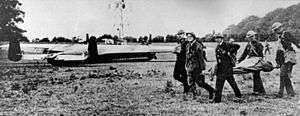Vernon Keogh
Pilot Officer Vernon Charles "Shorty" Keough (8 June 1911 – 15 February 1941) was an American pilot who flew with the Royal Air Force during the Battle of Britain in World War II. He was one of 11 American[2] pilots who flew with RAF Fighter Command between 10 July and 31 October 1940, thereby qualifying for the Battle of Britain clasp to the 1939–45 campaign star.
Vernon Charles Keough | |
|---|---|
_Squadron_RAF%2C_Pilot_Officers_A_Mamedoff%2C_V_C_'Shorty'_Keough_and_G_Tobin%2C_show_off_their_new_squadron_badge_at_Church_Fenton%2C_Yorkshire%2C_October_1940._CH1442.jpg) Vernon Keough (centre) with Andrew Mamedoff (left) and Eugene Tobin, RAF Church Fenton, Yorkshire, October 1940 | |
| Nickname(s) | Shorty |
| Born | 8 June 1911 Elizabeth, New Jersey, U.S. |
| Died | 15 February 1941 (aged 29) off Flamborough Head, East Yorkshire, England[1] |
| Allegiance | |
| Service/ | |
| Years of service | 1940–1941 |
| Rank | Pilot Officer |
| Service number | 81620 |
| Unit | No. 609 Squadron RAF No. 71 Squadron RAF |
| Battles/wars | World War II
|
Biography
Born in Elizabeth, New Jersey on 8 June 1911, the son of Charles K. Nezu and Constance Theresa Keough. He had earned a civil pilot's licence in America and was also a professional parachute jumper with over 500 jumps, performing at air shows across America.[3]
Second World War

He joined the French Air Force towards the end of the Battle of France, but as France fell he came to England with his friends and fellow Americans Andrew Mamedoff and Eugene Tobin and joined the Royal Air Force in 1940.
Keough was the smallest pilot in the whole of the Royal Air Force, hence the nickname, and was just 4'10" (approx 1.47m) tall. He had to use two cushions in his Spitfire to see out of the cockpit. On 8 August 1940 Keough was posted to No. 609 Squadron RAF at Middle Wallop airfield. He flew many missions during the height of the Battle of Britain in August and September. He was credited with one shared kill: Dornier Do 17 bomber shot down on 15 September with Pilot Officer Mike Appleby and Flight lieutenant John Dundas.
He was posted to RAF Kirton in Lindsey in Lincolnshire on 18 September 1940 and was a founder member of No. 71 'Eagle' Squadron along with Art Donahue, Andrew Mamedoff and Eugene Tobin.[4]
Death
On 15 February 1941, Keough was on a convoy-protection mission off Flamborough Head,[5] East Yorkshire. During the chase of a Heinkel He 111, he was last seen spinning off into the sea.[6] He may have been a victim of disorientation in cloud or oxygen failure. He was 29 years old. His body was not recovered, but he is remembered on the Air Forces Memorial at Runnymede.
See also
- Eagle Squadron
- List of Battle of Britain pilots
- Non-British personnel in the RAF during the Battle of Britain
External links
References
- "Archived copy". Archived from the original on 24 December 2015. Retrieved 24 December 2015.CS1 maint: archived copy as title (link)
- Battle of Britain - Roll of Honour
- "Archived copy". Archived from the original on 7 February 2009. Retrieved 3 February 2009.CS1 maint: archived copy as title (link)
- "Archived copy". Archived from the original on 24 December 2015. Retrieved 24 December 2015.CS1 maint: archived copy as title (link)
